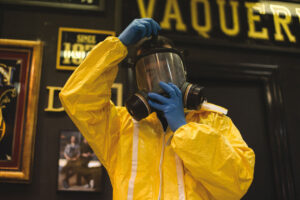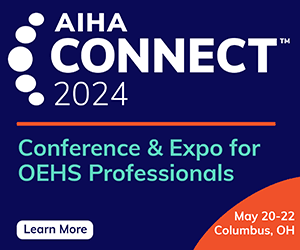Respirator Fit-Testing Methods (ANSI/AIHA/ASSE Z88.10-2010)
“A proper respirator fit test is a critical component of workers’ respiratory protection. Quantitative fit testing (QNFT) is the most accurate method—using data to calculate the fit factor. TSI’s PortaCount™ Respirator Fit Tester provides step-by-step guidance that measures the proper fit of the respirator using our Fit Pro™ Ultra software, which can also support qualitative (QLFT) test methods.” Jason Rutz, Global Product Manager, TSI, jason.rutz@tsi.com, 800-680-1220, TSI.com
History
 Developed by ANSI (now known as ASSP), with content provided by the American Society of Safety Engineers (ASSE), guideline Z88.10-2010 provides respiratory protection program managers (RPPM) with clear, consistent guidance on respirator fit-testing and the components required of an effective respiratory protection program. Included in the guide are instructions on how to avoid interference of PPE; it also provides detailed information on face pieces, including their selection, and other considerations for effective fit-testing. Z88.10 was last updated in 2010.
Developed by ANSI (now known as ASSP), with content provided by the American Society of Safety Engineers (ASSE), guideline Z88.10-2010 provides respiratory protection program managers (RPPM) with clear, consistent guidance on respirator fit-testing and the components required of an effective respiratory protection program. Included in the guide are instructions on how to avoid interference of PPE; it also provides detailed information on face pieces, including their selection, and other considerations for effective fit-testing. Z88.10 was last updated in 2010.
Qualitative fit-testing is a pass/fail test that uses the wearer’s sense of tasteor smell, or his reaction to an irritant, in order to detect leakage into the respirator facepiece. Whether or not a worker needs a full-face respirator or a half-mask respirator depends on the Assigned Protection Factor (APF). The APF is a number that describes the level of protection that a respirator can be expected to provide—if used properly.
Yearly fit-testing is now required. According to OSHA, an employer that performed fit-testing every two years reported 7% of their employees switched to different respirator sizes and/or models each time they were tested. OSHA considered this 7% measurement to be unacceptable and adopted the policy to require annual fit-testing and training.
Why Standard is Important
Fit-testing is a protocol used to evaluate sealing surface leakage of a specific, tight-fitting respirator while it is being worn. Individuals do not have to be issued the same respirator that they are fit-tested with, as long as they are issued a respirator that is the same make, model, style, size and material of respirator with which they are fit-tested. There are two categories of respirator fit-testing, which include qualitative and quantitative fit-testing methods.
Standard Z88.10 provides in-depth requirements for training fit-test operators; it also includes a large section entitled “General Considerations,” which covers in detail the important considerations for performing all respirator fit-testing protocols.
Clause 6 of the General Considerations section includes medical evaluation and pre-fit test training (such as how to don the respirator without assistance). Z88.10 recommends using a mirror to see how to position and adjust the respirator, for example. Also in this section are guidelines on how to inspect the respirator and how to accomplish user seal checks.
Key Compliance Requirements
There are numerous factors that could potentially diminish the effectiveness and fit of a respirator. These include:
- Weight gain or loss
- Dental work or facial surgery
- Significant scarring in areas where seal meets skin
- Wearer discomfort
- Facial hair or certain hair styles
- Cosmetics or facial jewelry
- Glasses or protective eyewear
- Do not perform fit-testing if any foreign material, like gels or creams, are present between the sealing surfaces of the face and the respirator
- PPE must not interfere with respirator sealing surfaces and must be worn during fit-testing
In addition, there are some other conditions that can adversely affect fit. These include possible facial feature interference, such as hollow temples, exceedingly protruding cheekbones, deep skin creases, absence of teeth or dentures, or facial injury including mouth or facial swelling.
If dentures are worn during respirator use, dentures should be worn during fit-
testing. If dentures are not worn during respirator use, then dentures should not be worn during fit-testing.
Resources:
- Copies of the standard can be purchased online, at the ANSI Webstore: https://bit.ly/2PKVCqb
Share on Socials!
Employer Responsibilities Under OSHA’s New Crystalline Silica Rules
How to Clean Safety Equipment
How to Safely Recover Combustible Dust
Leaders in Industrial Hygiene
Council for Accreditation in Occupational Hearing Conservation (CAOHC)
Subscribe!
Sign up to receive our industry publications for FREE!










